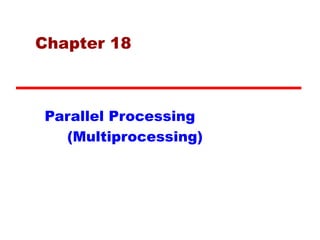
parallel processing.ppt
- 2. Its All About Increasing Performance • Processor performance can be measured by the rate at which it executes instructions MIPS rate = f * IPC (Millions of Instructions per Second) — f is the processor clock frequency, in MHz — IPC the is average Instructions Per Cycle • Increase performance by —increasing clock frequency and —increasing instructions that complete during cycle – May be reaching limit + Complexity + Power consumption
- 5. Taxonomy of Parallel Processor Architectures
- 6. Multiple Processor Organization • SISD - Single instruction, single data stream • SIMD - Single instruction, multiple data stream • MISD - Multiple instruction, single data stream • MIMD - Multiple instruction, multiple data stream
- 7. SISD - Single Instruction, Single Data Stream • Single processor • Single instruction stream • Data stored in single memory • Uni-processor Control Unit Processing Unit Memory Unit
- 8. SIMD - Single Instruction, Multiple Data Stream • Single machine instruction • Number of processing elements • Each processing element has associated data memory • Each instruction simultaneously executed on different set of data by different processors Typical Application - Vector and Array processors
- 9. MISD Multiple Instruction, Single Data Stream • One sequence of data • A set of processors • Each processor executes different instruction sequence Not much practical application
- 10. MIMD - Multiple Instruction, Multiple Data Stream • Set of processors • Simultaneously execute different instruction sequences • Different sets of data — SMPs (Symmetric Multiprocessors) — NUMA systems (Non-uniform Memory Access) — Clusters (Groups of “partnering” computers) Shared memory (SMP or NUMA) Distributed memory (Clusters)
- 11. MIMD - Overview • General purpose processors • Each can process all instructions necessary • Further classified by method of processor communication & memory access
- 12. MIMD - Tightly Coupled • Processors share memory • Communicate via that shared memory Symmetric Multiprocessor (SMP) - Share single memory or pool - Shared bus to access memory - Memory access time to given area of memory is approximately the same for each processor Nonuniform memory access (NUMA) - Access times to different regions of memory may differ
- 13. Block Diagram of Tightly Coupled Multiprocessor
- 14. MIMD - Loosely Coupled Clusters • Collection of independent uniprocessors • Interconnected to form a cluster • Communication via fixed path or network connections
- 15. Symmetric Multiprocessors (SMP) • A stand alone “computer” with the following characteristics: —Two or more similar processors of comparable capacity – All processors can perform the same functions (hence symmetric) —Processors share same memory and I/O access – Memory access time is approximately the same for each processor (time shared bus or multi-port memory) —Processors are connected by a bus or other internal connection —System controlled by integrated operating system – Providing interaction between processors – Providing interaction at job, task, file and data element levels
- 16. SMP Advantages • Performance — If some work can be done in parallel • Availability — Since all processors can perform the same functions, failure of a single processor does not halt the system • Incremental growth — User can enhance performance by adding additional processors • Scaling — Vendors can offer range of products based on number of processors
- 18. Time Shared Bus (vs Multiport memory) • Simplest form • Structure and interface similar to single processor system • Following features provided —Addressing - distinguish modules on bus —Arbitration - any module can be temporary master —Time sharing - if one module has the bus, others must wait and may have to suspend
- 19. Time Share Bus - Advantages Advantages: • Simplicity • Flexibility • Reliability Disadvantages • Performance limited by bus cycle time • Each processor must have local cache — Reduce number of bus accesses • Leads to problems with cache coherence
- 20. Operating System Issues • Simultaneous concurrent processes • Scheduling • Synchronization • Memory management • Reliability and fault tolerance • Cache Coherence
- 21. Cache Coherence • Problem - multiple copies of same data in different caches • Can result in an inconsistent view of memory —Write back policy can lead to inconsistency —Write through can also give problems unless caches monitor memory traffic MESI Protocol (Modify - Exclusive - Shared - Invalid )
- 22. Software Solution to Cache Coherence Compiler and operating system deal with problem • Overhead transferred to compile time • Design complexity transferred from hardware to software — Analyze code to determine safe periods for caching shared variables — However, software tends to (must) make conservative decisions — Inefficient cache utilization
- 23. Hardware Solution to Cache Coherence Cache coherence hardware protocols • Dynamic recognition of potential problems • Run time solution —More efficient use of cache • Transparent to programmer / Compiler Implemented with: • Directory protocols • Snoopy protocols
- 24. Directory & Snoopy Protocols Directory Protocols Effective in large scale systems with complex interconnection schemes • Collect and maintain information about copies of data in cache — Directory stored in main memory • Requests are checked against directory — Appropriate transfers are performed Creates central bottleneck Snoopy Protocols Suited to bus based multiprocessor • Distribute cache coherence responsibility among cache controllers • Cache recognizes that a line is shared • Updates announced to other caches Increases bus traffic
- 25. Snoopy Protocols • Write Update Protocol (Write Broadcast) —Multiple readers and writers —Updated word is distributed to all other processors —Multiple readers, one writer • Write Invalidate protocol (MESI) —When a write is required, all other caches of the line are invalidated —Writing processor then has exclusive (cheap) access until line is required by another processor MESI Protocol - State of every line is marked as Modified, Exclusive, Shared or Invalid - two bits are included with each cache tag
- 26. Processor Designs • Pipelined ALU —Within operations —Across operations • Parallel ALUs • Parallel processors